West Bengal Institute of Technology (WBIT) 2009-2nd Sem B.Tech Electronics and Communications Engineering Electronics & Comm ( - ) Engineering Thermodynamics & Fluid Mechanics (Solved Part 1 ) - Quest
, ' Group A
(Multiple Choice Questions)
1. Choose the correct alternatives of the following : 10x1
(i) A perpetual motion machine is
(a) a thermodynamic machine (b) a non-thermodynamic machine (c) a real machine (d) a hypothetical machine whose operation would violate the laws of thermodynamics
(ii) A thermodynamic system may be defined as a quantity of matter upon which attention is focused for study if
(a) it is only bounded by real surface (b) the boundary surface is constant in shape and volume (c) it is not bounded by an imaginary surface (d) it is bounded by either real surface or imaginary surface, irrespective of shape or voulme
(iii) The expression J Pdv may be applied for obtaining work os *
(a) non-flow reversible process (b) steady flow reversible process (c) steady flow non-reversible process (d) steady flow adiabatid*eversible process
(iv) -The gas constant (R) is equal to the .
(a) sum of two specific heats (b) difference of two specific heats .
(c) product of two specific heats (d) none of these
(v) A camot cycle operates between the temperature of 1000 K arid 500 K. Then the efficiency of the cycle is
(a) 50% (b) more then 50% (c) less than 50% (d) none of these
(vi) In a reversible cycle, the entropy of the system
(a) increases (b) decreases
(c) does not change (d) depends on the properties of working substances
(vii) The latent heat of vaporization at critical point is
(a) less than zero (b) greater than zero (c) equal to zero (d) all of these
(viii) The work output of the theoretical Otto cycle
(a) increases with increase in compression ratio (b) increases .with increase in pressure ratio (c) increases with increase in adiabatic index y (d) follows all of these
(ix) Atmospheric pressure is
(a) Gauge pressure-Absolute pressure . (b) Absolute pressure-Gauge pressue (c) Absolute pressue-Vacuum pressure (d) Gauge pressure-Vacuum pressure
(x) A differential manometer is used for measuring the
(a) pressure at a point , (b) velocity at a point
(c) difference of pressure at two points (d) discharge
(xii) During the throttling process
(a) internal energy does not change (b) pressure does not change (c) entropy does not change (d) enthalpy does not change
|
. WBUT (MECHANICAL SCIENCE) QUESTIONS2009 (xi) Reynolds number is expressed as |
 |
Ans. (i) d ; (ii) d ; (iii) a; (iv) b ; (v) a; (vi) c ; (vii) c ; (viii) d (ix) b ; (x) c ; (xi) a ; (xii) d.
' Groujv-B (Short Answer Type Questions)
Answer any three Questions
2. (a) What is the quality of wet stream? ,
(b) What is the difference between a refrigerator and a heat pump? Establish the relation : COPHp = COPR + 1. . 2+3
Ans. (a) Quality or dryness fraction is defined as the ratio of mass of saturated vapour to the total mass of the mixture. That is,
mass of saturated vapour mg mg
total mass of mixture m nu + m
. f g
8
where m = total mass of liquid-vapour mixture mf = mass of saturated liquid mg = mass of saturated vapour
Ans; (b) The transfer , of heat from a low temperature medium to a high temperature medium requires speial devices called refrigerators and heat pumps.
Refrigerators and heat pumps are simply heat engines operated in the reverse direction.
A heat pomp is a device which works on a cycle, maintains temperature of a body which is more than the temperature of surroundings.
The objective of a refrigerator is to maintain the refrigerated space at a low temperature by reoving heat from it. A refrigerator operates between the ambient temperature and a low temperature.
The objective of a heat pump is to reject heat to a high temperature body. A heat pump operates between the ambient temperature and a high temperature.
3. Prove that entropy change for an ideal gas
-i 4.rar In 2

Ans. For an ideal gas, dh = Gp dT, Pv = RT and du = Cv dT WBUT (2nd Sem)16
\
The characteristic gas constant R = Cp - Cv
From the property of thermodynamic relation, we can write-
Tds = dh - vdP .
. dh vdP dT dP
=> ds ----= L p --- K
T T TP
Integrating between any two states 1 and 2 for an ideal gas
2
h.
ds = [CP In T- R Iii P]2 =CP ln--.R ln-= CP Iir{CP-Cv)tn--
........ji
In- + C,
V|
In- =CP Pi -
T2Pl
t,p2
, In
P)
= Cp lnfJ- + Cv
4. A 0.025 m3 vessei contains OJ kg of steam at 2 MPa. Determine the quality and enthalpy of steam. Given t, =* 2X2.2C, vf = 0.001177 m3/kg, v = 0.0995 nrVkg, hf = 908.5 kJ/kg, hfg = 1888.7 kJ/kg, af = 2.447 kJ/kg-K, sfg = 3.590 kJ/kg-K. 5
Soln. : Specific volume of the stea '
V 0-025
= 0 083 m3/kg
m 0-3
Let x be the quality of the steam. ,
v = vf+x(vg-vf)
The specific enthalpy of the wet steam
h = hf + x(hg - hf) = 908-5 + (0-8322X1888-7) = 2480-28 kJ/kg
1 5. State and prove Pascals law of pressure at a point of a fluid body.
Ans. Pascals law states that pressure (or intensity of pressure) at a point in a static fluid is equal in magnitude in all directions.
It, let a small wedge shaped fluid element of unit length in equilibrium be considered. The mean pressures at the three surfaces are Px, Pz and PK The forces acting on the element are pressure forces on the surfaces and the gravity forces. The force acting on the surface is the product of the mean pressure and the surface area.
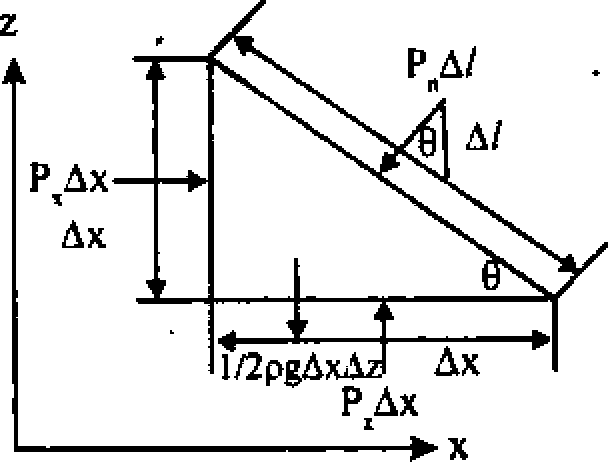
Figure. Static equilibrium of a fluid element.
WBUT (MECHANICAL SCIENCE) QUESTIONS2009 243
From Nowtons second law, a corce balance in the x and z directions gives
Pj.Az - Pn/sin6 =0 ,
XFx= ' '
P7Az - Pn/cos0 - pgAxAz = 0
Ay A?
where p is the density and pg~ is the weight of the fluid element. From the Figure,
(right angle triangle) Ax = /cos9 and Az = /sinO.
Substituting these in equaitons.
Px-Pn = 0
Pz PSA2 = 0
The last term of the equaiton drops out as Az > 0 and the wedge becomes infinitesimal and thus the fluid element shrinks to a point.
Then from equations, Px = Pz = Pn = P
We can repeat the analysis for an element in the y z plane and obtain a similar result. TI\us, the pressure at a point in a fluid has the same magnitude in all directions.
6. (a) State Newton laws of viscosity.
(b) A large plate moves with a speed v0 over a stationary plate on a layer of oil. If the velocity profile is that of a parabola (as shown in figure) with oil at the plate having the velocity as the plates, what is the shear stress on the moving plate from the oil? 4
|
Linear profile |
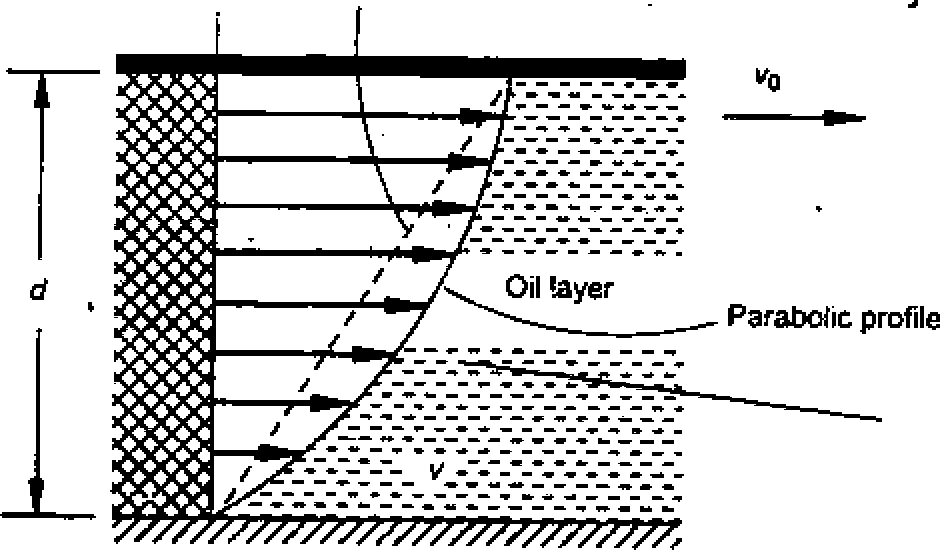 |
Soln. : (a) Newtons law of viscosity states that for a well-ordered flow whereby fluid particles move in straight, parallel lines (parallel flow). Newton's law of viscosity states that for certain fluids, called Newtonian fluids, the shear stress (t) on an interface tangent to the
/du
direction of flow is proportional to the distance rate of change of velocity > where the
differentiation is taken in a direction normal dy to the interface.
Mathematically, Newtons law of viscosity can be expressed as
du
' TOC-- ' . -
dy '
du >
dy
where, the constant of proportionality \i is known as the viscosity coefficient or simply the viscosity which is the property of the fluid and depends on its state. Common fluids, such as water, air, mercury obey Newtons law of viscosity and are known as Newtonian fluids.
. Soln.: (b) Let the equation of the velocity profile (parabolic) be ,
u = Ay2 + By + C
where A, B and C are constants and their values are determined-from boundary conditions. Boundary conditions are
(i) u = 0 at y = 0
(ii) u = v0 at y = d
du . . 1 .
(Hi)0aty = d -
From(i), 0=A(0) + B(0) + C - ' v0 = Ad2 + Bd -
du . . _
From (iii), - 2Ay + B
0 = 2Ad + B
vQ 2vQ
After solving the above equations, we get A = j and B *= -j-
v 2v du. 2V0
The velocity profile becomes u = y2 + y or ~T~ ~7T +
d d y d
du .
Velocity gradient - -240y + 24
Shear stress on the moving plate from the oil is given by
7. fa) Prove that where, PV*= mRT where P = pressure, V = volume of m mass of gas, r-temperature, R * characteristic gasi constant* 4
(b) Write down the signifli&nce of the universal gas constant (Rm) and prove that
" Rm ' ' " v :
R = , where M- molecular weight of the substance. . 2+4
(c) When 0.1421 kg of a gas is heated from 27C to 27C, it is observed that the gas requires 202 kJ of heat at constant pressure and 142 kJ of heat at constant volume. Find the adiabatic characteristic of gas constant and molecular weight of the gas. , 5
ABs fa) For an ideal gas P v = RmT............(l) ;*
When R,,, is the universal gas constant, y is the volume per unit mole.
SinceV is the total volume and n is the number of moles of the gas.
_ _ V ; ' '
nv = V => v = .............(2)
n
From (1), we can write-
= RmT => PV = nRj,,!..................(3)
If M is the molecular mass and m is the total mass of the gas then' - s ........V- ;
From (3) PV = RmT = m-T = mRT [ v = R, R is characteristic gas constant].
M M M -
Ans. (b) The universal gas constant is the same for all gases. 1 kg mole of all gases occupy the smae volume and the Volume of 1 kg mole of all gases at NTP (273-115k and
1-0132 per) is 22-4146 m3. ,
Ans. (c) Given .
m ~ 0-1421 kg
Ti = 27C ' :
- T2 = 127C *
, mCp(T2 - Tj) = 202 kJ or, (0*1421) Cp (127 - 27) = 202 kJ or, Cp = 14-2153 kJ/kgC Again, mCv (T2 - T,) =142 kJ (given) or,.(0-1421) Cv (127 - 27) = 142 kJ or, Gv = 9-993 kJ/kgC .
Characteristic gas constant, R - Cp - Cv = 14-2153 - 9-993 = 4-2223 kJ/kgC S 8*1143
Molecular weight, M = = -= 1 969 kg / kgmol.
- R 4 * 2223 . .
( V,2
uL+pivi+-y-+gzi
+ W
m
8. (a) What is steady flow process? Write the steady-flow energy equation for a single stream entering and a single stream leaving a control volume and explain -the various terms in it. Calculate work done from SFEE for turbine.
(b) A turbine operates under steady flow condition and receiving at the following conditions: .
Pressure = 1.2 MPa, Temperature = 188C, Enthalpy = 2785 kJ/kg, velocity = 33.3 m/s and elevation ** 3m.
Steam leaves the turbine at the following state :
P = 20 kPa, V = 20 kPa, V - 100 m/s, enthalpy = 2512 kJ/kg and heat lost to the surrounding at the rate 0.29 kJ/sec and the rate of steam flotr through the turbine is 0.42 kg/sec. What, is the power output of the turbine in kW? 8 Ans. (a) A steady flow is defined for a control volume as that type of flow in which the thermodynamic properties at a given position within or at the boundaries of the control volume are invariant with time. The properties include temperature, pressure, density, internal energy as well as velocity and acceleration of the flow stream. However, in a steady flow process, the state of the fluid can change as it passes through the control volume.
The steady flow energy equation for a single stream entering and a single stream leaving a control volume can be written as .
2 . \
' % U2+P2V2+- + gZ2
, rh, = mass flow rate at inlet
m, = mass flow rate at outlet
Uj = specific internal energy of fluid stream at inlet
u2 = specific internal energy of fluid stream at outlet
P,vj = specific flow work done on the control volume by the entering fluid
P2V2 = specific flow work done by the control volume on the leaving fluid
Vj = velocity of fluid stream at inlet
V2 = velocity of fluid stream at outlet
Vj = specific volume of fluid at inlet
v2 = specific volume of fluid at outlet
Q = rate of heat added to the control volume
\V - rate of worlj done by the control volume during the same time.
Ans. (b) Mass flow rate = 0-42 kg/s '
hj =2785 kJ/kg Vj = 33-3 m/s
Where
Z, =3m
h2 = 2512 kJ/kg V2= 100 m/s Z2 = 0m
Rate of heat transfer = - 0-42 * 0 29 * 103 J/s
|
m |
|
|+W | ||||||
|
.42fr> 33'y \ 0-422785 x 10 + | ||||||||
- 042 x 029 x 10
+ 9-81
+ W_
W =112683-4 J/s = 112 68 kW. s ,
9. (a) Derive an expression for continuity equation for a three-dimensional steady incompressible flow.
(b) A jet of water from a 25-mm diameter nozzle is directed vertically upwards, assuming that jet remains steady and neglecting any los of energy. What will be the diameter at a point 4*5 m above the nozzle, if the velocity with which jet leaves the nozzle is 12 m/s?
i
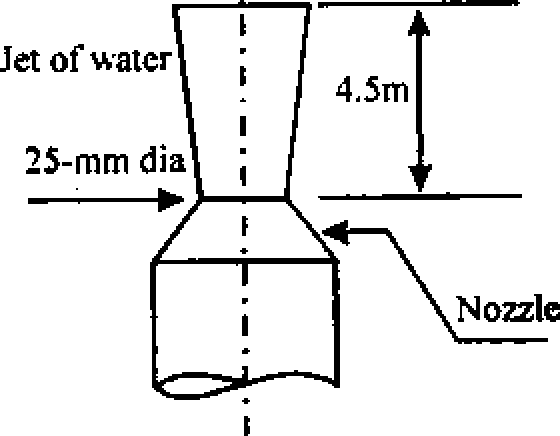
(c) The velocity vector for a 2D incompressible flow field is given by
_ x * y *
v = =-5 i + -j-J j. State whether the flow is continuous or discontinuous. 5
x +y x +y
Ans. (a) A rectangular parallelepiped with sides dx, dy and dz in the x, y and z directions, respectively, is considered as the control volume in three-dimensional Cartesian coordinates.
Let hte fluid enter through the surface ABCD (normal to the x-axis) with a velocity u and a density p. Rate of Rate of mass inflow through the surface ABCD (normal to x axis) = pudydz
|
WBUT SOLVED BOOK B p |
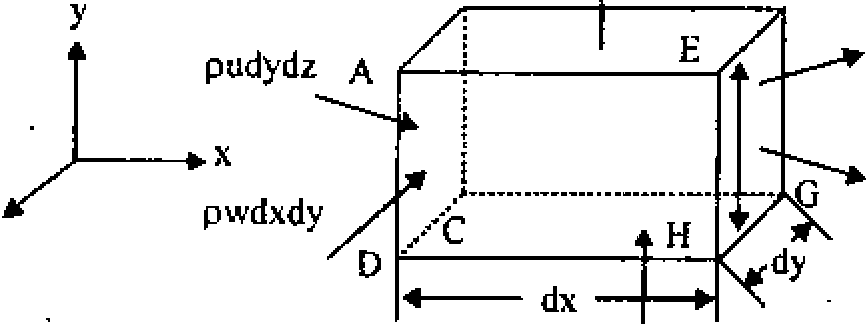 |
|
pvdxdz |
[pw+(pw)dz]dxdy
[pu+&(pu)dx]dydz
Rate of mass outflow through the surface EFGH (normal to x axis) =
pu +(pu)dx <5x '
dydz
p \
Net rate of mass outflow in x direction = (pu) dxdydz ox
Similarly,
Net rate of mass outflow in y direction =lPv) dxdydz
* 0
Net rate of mass outflow in z direction = (pw) dxdydz
oz -
Therefore, total net rate of mass outflow in x, y and z direction
dxdydz
-~"(pu) + -~(pv) + (pw)
Hie effect of mass loss in Eq (0,1) is to cause the time rate of decrease of mass encompasses by he volume.
3p . .
Since ~ is the rate of change of mass density, the rate of change of mass in control
dp
volume = - dxdydz.
Therefore, according to the principle of conservation of mass,
Total net rate of mass outflow in x, y andz direction = rate of change of mass in control volume -
dxdydx = dxdvdz dt '
d d , ,df v d . ,
+ (putr pu) + pw)
dt dyK *dzy } dzK
dxdydx = 0
Since the volume of control volume can not be zero, the above equation, becomes
Equation (.2) is known as continuity equation.
a+M+.(pv)+fe(pw)=o ap+u+v+w+p|J++5w
= 0
at 5y 5z n9x 5x
Dp
IX+P
0u . dv , dw | n
ax+ax+ax1=0
lDp dU'dv ,dw_n , pDt <5x dx. dx.
For incompressible flow, the rate of volumetric dilation per unit volume .(~r) of a fluid
p Dt
element in motion is zero. Then the above equation becomes
3u dv dw n . . '
+ * = 0 v ' - : '
. dx dx dx . - - - . ... . .
Rjuation (13.6) cto fee written in a vector form as A.V = 0.
Ans. (b) Let the nozzle exit and the point 4-5 m above the nozzle be designated by point
1, and 2 respectively, as shown in Fig. ~ ,
B eUr zzlt 0 i = 25 mm = 0-025 m Velocity of jet at the exit of the nozzle V j = 12 m/s
Let the diameter of the jet at a point 4-5 m above nozzle be D2 and velocity of jet at point
2 be tn/s. , , ' .
Considering the motion of the jet from the exit of the nozzle to point 2, we have V-,2 = V,2- 2gh . ' / . . , : 2
where h is the distance between point I and 2 (here A = 4-5 m)
Putting the values of Vt and h, we get V22 - 122 - 2 * 9-81 x 4-5 or, V2 = 7-46 m/s
Applying the continuity equations between the exit of the nOzzle and the point 2, we have A,V] = A2V2 .
or, or,D22 = D12- = 0 0252 or, D2 = 0-0317 m
Ans. (c) The contimuity equation in differential form for a two-diamensional, incompressible flow is- '
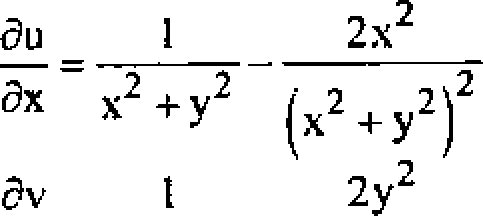 |
|
(x2 + y2)2 |
3u 5v
+ = 0
dx dy
Velocity field satisfies the continuity equation. Therefore, the flow is continuous.
10. (a) Draw the nature of p - v and T - s plots of a Rankine cycle (with saturated steam at turbine inlet). 4
(b) A lump of steel of 15-kg mass at 557C is dropped in 120 kg of oil at 25C. The specific heats of steel and oil are 0,5 kJ/kg-K respectively. Calculate the entropy change of the steel the oil and the universe.
(c) The bodies, each of equal mass m and heat capacity C are of temperature T, and T2 (Tj > T2) respectively. The first body is used as source of heat for reversible engine and the second body as the sink. Show that the maximum
work obtainable from such arrangement is 2
Ans. (a) The Rankine cycle is an ideal cycel for vapour cycles. The cycle is shown in Fig. on P - v and T - s diagrams, the Rankine cycle comprises of the following processes :
4 - 1 : Reversible (constant pressure) heat addition in a boiler
1 - 2 : Reversible adiabatic expansion in a turbine
2 - 3 : Reversible (constant pressure) heat rejection in a condenser
3.-4; Reversible adiabatic compression in a pump '
Dry saturated steam enters the turbine and expands reversibly and adiabatically to condenser pressure. The steam is then condensed at constant pressure and temperature to a saturated liquid. The saturated liquid leaving the condenser is then pumped reversibly and adiabatically into the boiler pressure. The compressed liquid is first heated to the saturation temperature at boiler pressure and then evaporated to the state 1 to complete the cycle.
|
p j |  |
|
v | |
s
Fig. Rankine cycle on P - v and T - s diagram
Ans. (b) Let the final temperature be Tf .
15 0.5(557 - Tf) = 120 * 3.5(Tf-25) Tr= 34.33C = 307.33K.
lf SQ J
Tntropy change of steel = J = mCp/nf- = 15 x 0-5 /n
 |
|
830 |

Entropy change of universe = Entropy change of steel + Entropy change of oil = 7-45 + 12-95 = 5.5 kJ/K
Ans. (c) As heat is.transferred from the first body and heat is rejected to the second body, the temperature of the first bod will be decreasing and that of the second body will be increasing. When both the bodies attain the same temperature, the heat engine will stop operating.
Let Tf be the final temperature.
Total heat transfer from the first body, Qt = mCp(T, - Tf)
Total heat rejected to second body, Q2 = mCp(Tf- T2)
Work done by the heat engine, W = Qt - Q2
W = mCp(T, + T2 - 2Tf)
For minimum value of Tf maximum value of W will be maximum.
|
. First bocty initially al r, | ||
|
Heat *ng in* | 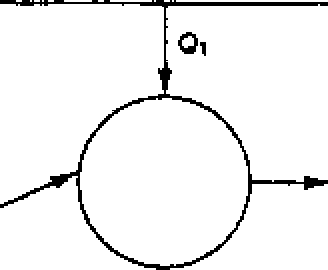 |
W |
Second body initially at at Tt
Change of entropy of the first body


Change of entropy of the second body 2 -
We know that the heat engine is a cyclic device, and cyclic integral of any property is zero. Since entropy is a property of a system.
Entropy change for the heat engine, ASjjg = AS j + AS2 + AShe Total entropy change of the universe ' '
= AS, + AS2 + AShe = mCp lni + mCp /n = mC /ni-
(AS),
' *1 2 , 12
From the entropy principle (AS) j > 0
mC /nL-p T.T.
1 2
For minimum value of Tf
mC ln = 0
P TT
V2
/n-- = 0= In 1
TT
1 2
Maximum work obtainable Wmjix -mCfr. *2) =mCp(T--TJ
5 + 3
11. (a) Prove that PV in adiabatic process and also prove
|
Y-J | ||||||
|
(b) What is a cyclic heat engine? Find the efficiency ef heat engine in terms of soarce and sink temperature.
Which change is more effective to increase the efficiency of the engine. 1+3+3 Ans.(a) From the first law of thermodynamics we get 8Q-8W = dU
5W = - dU ' . '
w,-2 = u,-u2 ..
For adiabatic process, 8Q = 0 *
Now, for a non-flow process, 8Q = dU + PdV For an adiabatic non-flow reversible process,
0 = dU + PdV
0 = m. c..dT + PdV
dT =
PdV
m.c.
For an ideal gas, PV = m.RT PdV + VdP = mRdT
PdV
mC
V
PdV + PdV = mR
Cv (PdV + VdP) + (Cp - cv) PdV * 0
dV dP dV dV A , Dividing by CvPV, we get ++ y- ~ ~ 0
dP_dV ' P ~ 1 V Integrating, we get
In P + y In V = In constant PV* = constant
= 0
P1V1r = P2V2r
f-
A
v2
lvl
t2 p2 v2
vV,;
T2 P2 V2 p2 \ P
Y-l
II-
Ans. (b) The heat engine that operates on the Carnot cycle is called the Carnot heat engine. The thermal efficiency of any heat engine is given by '
Q1Q2 _ , 92,
_L
|
Attachment: |
| Earning: Approval pending. |
